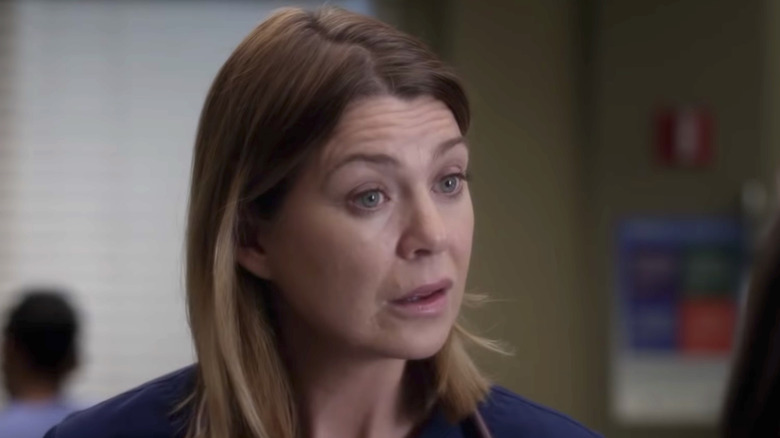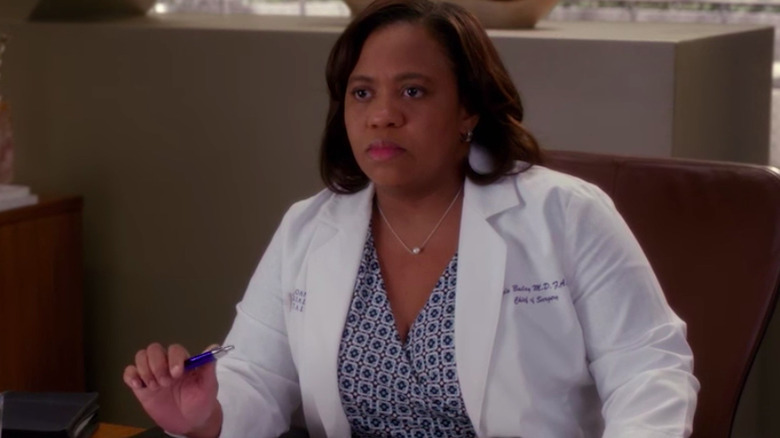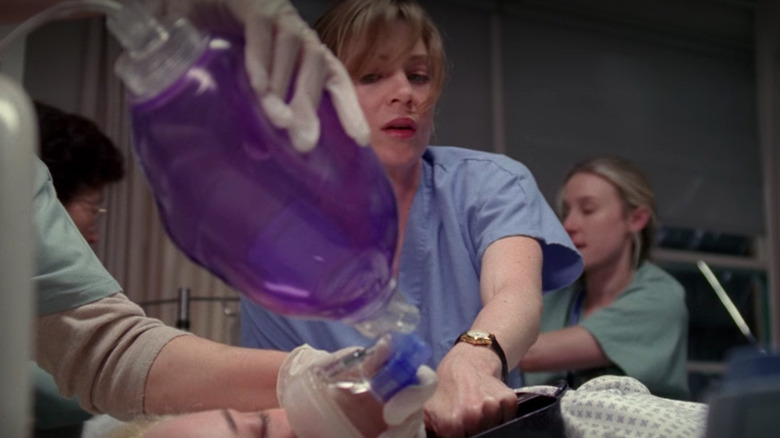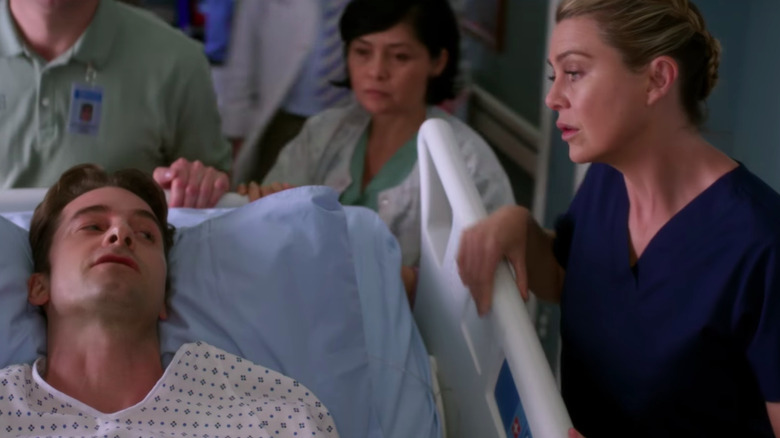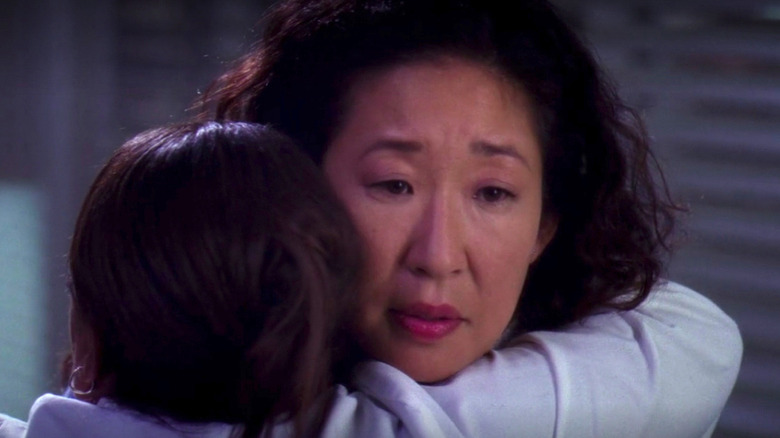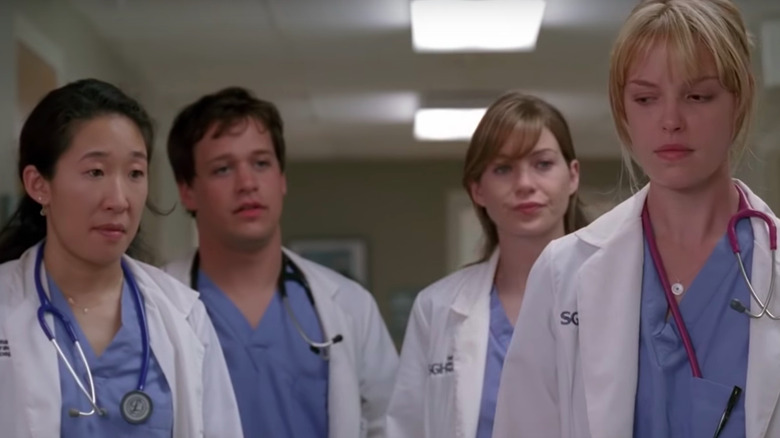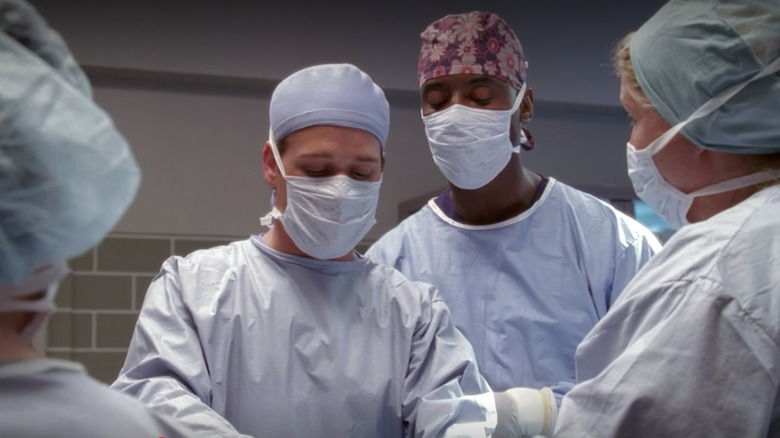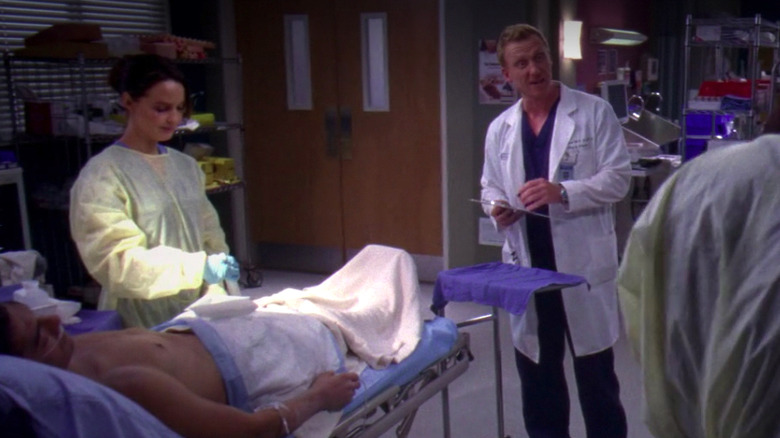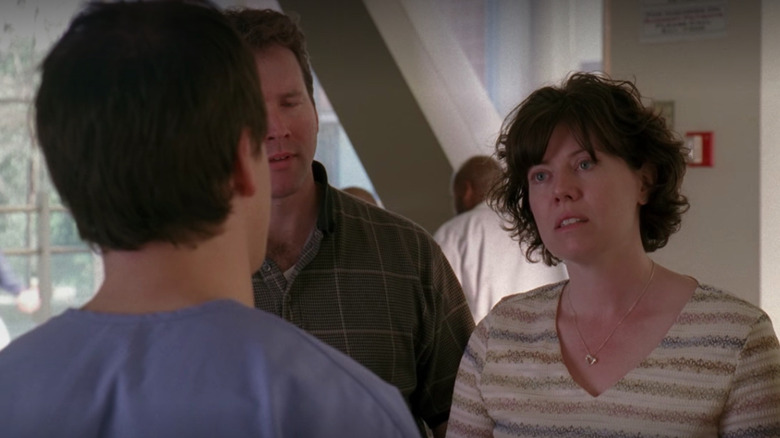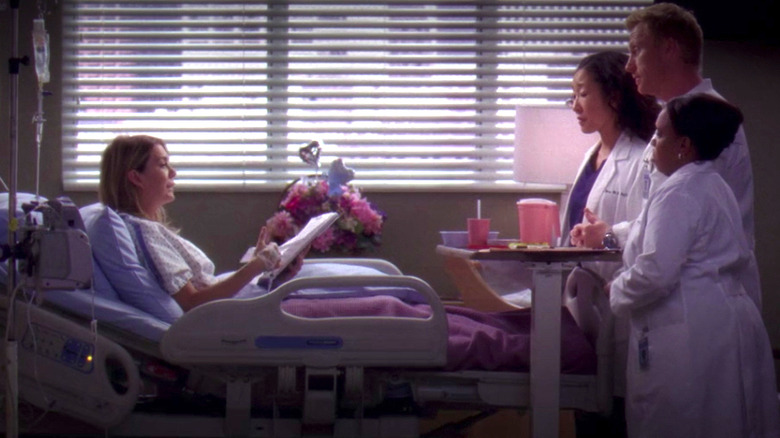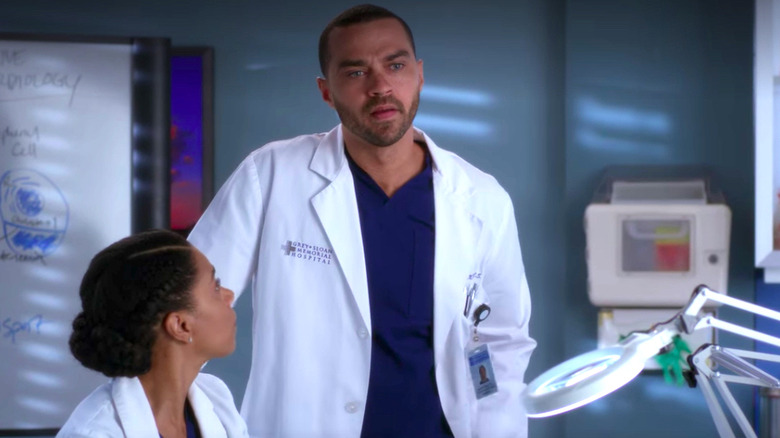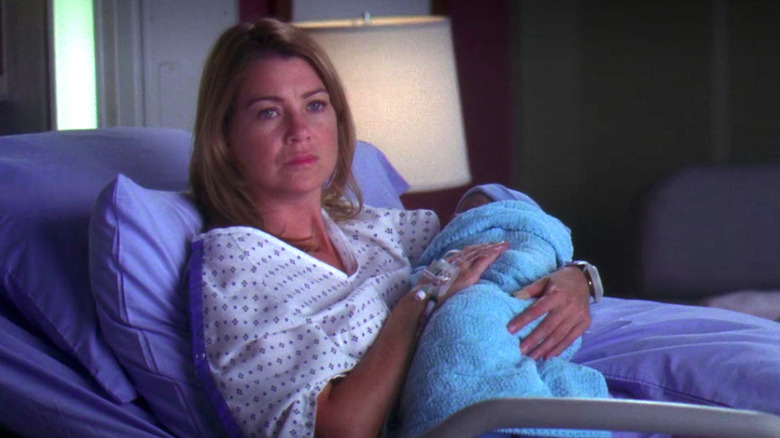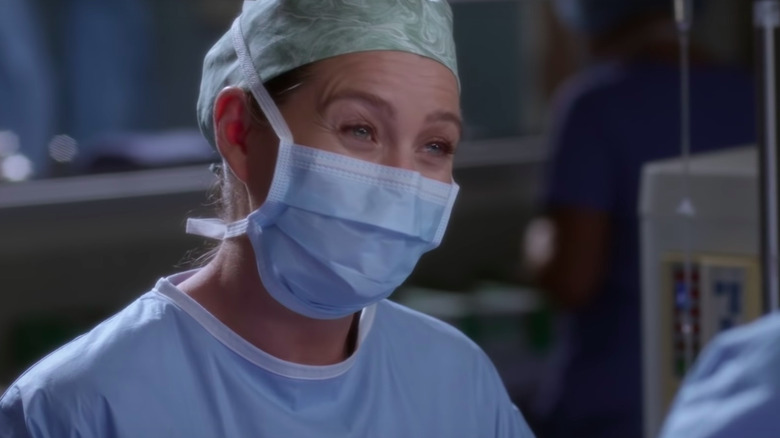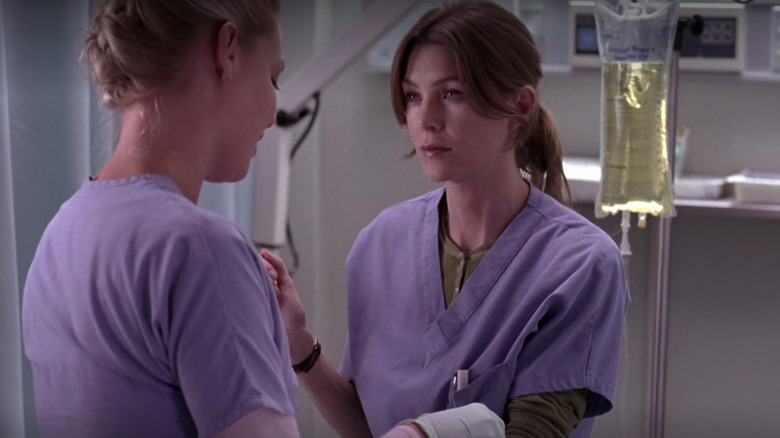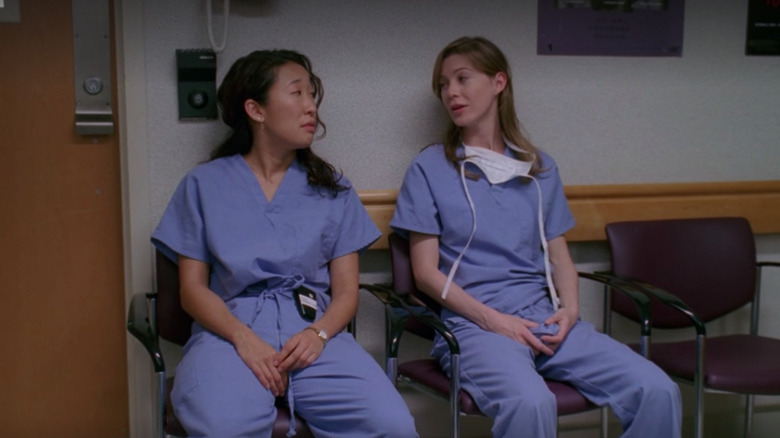False Things Grey's Anatomy Made You Believe About Medicine
ABC's Grey's Anatomy is television's longest-running medical drama in TV history. Fans everywhere have fallen in love with the drama that's unfolded for over a decade at Grey Sloan Memorial Hospital. But while creator Shonda Rhimes obviously knows how to make great television, she's not a medical expert.
Many times, the series has been not-so medically accurate, but honestly, the truth's just not as exciting to watch. Grey's Anatomy episodes usually follow rare cases that real doctors don't see much of. "We're the 1 percent hospital," executive producer Zoanne Clack told Entertainment Weekly, noting, "We have a file of strange, mysterious, fun, and interesting cases to draw from." Real doctors aren't so impressed. "If there's a real gap between [expectation and reality], it makes it a relatively poor experience for the patient, and it transfers to a poor experience for the nurses and doctors trying to take care of this patient who feels very frustrated," Dr. Jordan Weinberg said in his study regarding effects the show has on viewers (via Time).
Here are false things Grey's Anatomy made you believe about medicine.
According to Grey's Anatomy, doctors are always treating patients or in operating rooms
Being a doctor in Grey's Anatomy has always looked so exciting. They're constantly tending to an emergency surgery or running around as they race against the clock to solve yet another curious medical mystery. However, that's really not always the case. In fact, it usually isn't.
Doctors spend a majority of their time — drum roll, please — filling out paperwork. According to a 2016 study published by Annals of Internal Medicine, they spend only a little over a quarter of their day with patients and almost double that tending to the necessary paperwork. Furthermore, the study found that even while in the examination room with a patient, a doctor spends an average of 37 percent of that time filling out papers while diagnosing the patient's illness. Needless to say, Grey's Anatomy probably wouldn't have lasted so long with if fans had to watch doctors doing desk work all day.
Doctors drag out the defibrillator when a patient's heart stops like on Grey's Anatomy
Doctors have their own language, which makes dialogue in Grey's Anatomy even more intriguing. For example, when one of the medical professionals shouts "code blue," it means that the patient's heart has stopped beating. As doctors rush to their aid, viewers are more than likely to see them with a defibrillator. "Clear!" a doctor usually yells as they zap the patient's chest to regain a heartbeat.
As exciting as this is to watch, it's unfortunately not reality, and yet it occurred in the very first episode of the series. "The defibrillator is actually meant for people who have an irregular heart rhythm, the technical term of which is arrhythmia," Beverly Hills Concierge doctor Ehsan Ali told Digital Spy. The electrical pulse is used to restore a heartbeat back to regularity, not bring it back from nothing. The first thing a doctor would do during a code blue is perform chest compressions, according to medical professional and YouTuber Doctor Mike.
There's nothing quite like someone receiving an electric shock to make a dramatic scene even more shocking to viewers, though.
Experimental treatment happens pretty frequently just as it does on Grey's Anatomy
As many Grey's Anatomy episodes follow storylines that focus mostly on rare illnesses and diseases, it would make sense that treatments would not be fully developed and have to be mostly experimental. After all, this is a great ploy from the show's writers, as this concept makes viewers stick around for the whole episode because they have to find out how it will end. However, as frequent as these trial treatments have become over the span of the medical drama series, it's not usually a common practice outside of Grey Sloan Memorial Hospital.
"If it was the better treatment option, it wouldn't be experimental," Andrew Holtz, author of the book The Real Grey's Anatomy, told Monster. "Experimental means you don't know if it's better or not." With that being the case, it's not the usual treatment plan that real-life doctors would turn to, but, on television, it would only make sense to have Dr. Meredith Grey, Dr. Derek Shepherd, and the gang be risk-takers.
According to Grey's Anatomy, trauma patients have a high death rate
Grey's Anatomy obviously showcases a lot of heightened medical conditions in order to keep up with the drama and suspense that engages so many avid fans. With the show taking place in a hospital setting, the characters find themselves in many life or death situations that keep viewers on edge. With the odds against most of the patients portrayed on-screen, watching this type of intense content can make just about anyone scared to be admitted to a hospital.
However, a study done by the surgery department at St. Joseph's Hospital and Medical Center in Phoenix, Ariz. has some good news. They compared the results of over 48,000 real-life trauma patients with 290 trauma patients from episodes of Grey's Anatomy and found some pretty interesting results. Patients in the television series had more than three times the death rate than a real-life trauma patient, so viewers can rest assured that the odds are more in their favor than they may have thought.
Residents work ridiculously long shifts like the characters on Grey's Anatomy
In the first episode of Grey's Anatomy, the medical residents are on their very first shift at the hospital. That day, they are introduced to surgeon Miranda Bailey, who tells them, "Your first shift starts now and lasts 48 hours. You're interns, grunts, nobodies, bottom of the surgical food chain. You run laps, write orders, work every second night until you drop, and don't complain!"
Sure, doctors are known to work long, strenuous hours that even include overnight shifts, but medical professional Doctor Mike said in one of his popular Youtube videos, "Residents don't work 48-hour calls anymore." He explained, "They're capped at 80 hours per week, maybe they go a little bit over that sometimes, but 48 hours is just non-existent, and this started because of the Libby Zion Law." This law began in 1989, after 18-year-old Libby Zion passed away unexpectedly shortly after being admitted to the emergency room. Her death was attributed to the fact that she was only seen by medical residents, who were receiving little supervision and tending to multiple patients at once.
Grey's Anatomy fans know Miranda Bailey is tough on interns, but she legally can't be.
First-year residents perform surgery just as they do on Grey's Anatomy
The first-year medical residents that are seen in Season 1 of Grey's Anatomy go on to become the characters in the series that fans care the most about. The show builds up these aspiring doctors for viewers to get to know, so it would only make sense that they would be the ones taking appointments with patients and performing surgery, right? Wrong.
Not only would most real-life patients not want someone in training handling their risky surgery, but it would just never happen in a real hospital. "Most of the actual surgery is done by chief residents and attending surgeons," Andrew Holtz, author of the book The Real Grey's Anatomy, told Monster. "First and second year residents spend more time on the floor, learning how to care for patients and observing." When first-year resident George O'Malley gets chosen from among his peers to perform an appendectomy in Season 1, viewers can be thankful this scenario would never actually happen in the real world.
"75 [dollars] says he can't even I.D. the appendix," Cristina Yang comments in the episode. Yikes.
Surgeons like those on Grey's Anatomy take patients immediately from the ER to the OR
When a patient arrives in the emergency room, chances are they won't be brought into the operating room as quickly as they would at Grey Sloan Memorial Hospital.
A study done by the surgery department at St. Joseph's Hospital and Medical Center in Phoenix, Ariz. examined 269 episodes of Grey's Anatomy and compared the show's surgery patients with those in real hospitals. In the television series, 71 percent of patients went straight from the emergency room to an operating room. In reality, only 25 percent of real-life emergency patients ended up straight in surgery, according to the study. Viewers more than likely don't want to watch a full episode where a patient lies in a bed, so it only makes sense why the show's writers would make the risk of surgery even higher for its made-up patients.
The overall conclusion of the study said that this type of overdramatic medical portrayal in television can "cultivate false expectations among patients and their families" and perhaps even deter people from visiting the emergency room. Though when in doubt, it's always better to get checked out.
Private conversations with patients occur in the waiting room, according to Grey's Anatomy
With the stakes being so high after the many emergency surgeries being depicted in the show, there always seems to be a dreaded moment in Grey's Anatomy when the doctor has to go speak with a family about some very bad news. These conversations are obviously not easy to have, and, unfortunately, real doctors have to have them with families too.
"Kind of shows you that doctors are sometimes put into really tight spots," medical professional Doctor Mike said in a Youtube video. However, when a doctor has to be the bearer of bad news, there's definitely a better place to do it than in the waiting room where there are tons of other families. "These conversations don't happen in the open. This is not right," Doctor Mike said, noting that doctors need to find a more private space to have these serious discussions.
Doctors are with patients during every part of their hospital stay, as seen on Grey's Anatomy
While the Grey's Anatomy doctors are seen wheeling patients around the hospital, injecting them with medications, and taking their blood pressure, this really isn't their job.
Andrew Holtz, author of the book The Real Grey's Anatomy, told Monster that this is one of the biggest medical myths that the show portrays. "Giving patients injections, making sure they have their medicine, taking their blood pressure and doing hands on things with the patient in the hospital room, that's almost all nursing care." Yes, in reality, nurses play an integral part in any patient's experience at the hospital.
Clearly, the television series has many of the lead doctors performing these tasks in order to give them more on-screen time and to develop their characters even further. However, it's important for patients to know that their doctor isn't a jack of all trades, and there is an entire team behind them when they check into the hospital. Dr. Ehsan Ali, a house-call specialist to celebrities, told Digital Spy, "When complicated issues arise, we need the help of a specialist."
Doctors can print 3D replacement organs, as seen on Grey's Anatomy
After reading WebMD or watching Grey's Anatomy, many people feel as though they can diagnose their illnesses. A study showed that 42 percent of older adults said television was their primary source for health information. This may not necessarily be for the best.
When a journalist for Medical Bag asked doctors if they had ever had an experience with a patient who had unrealistic expectations, a physician's assistant from North Carolina spoke up. He said after his patient had seen an episode of Grey's Anatomy, in which Dr. Meredith Grey attempted to print a newborn baby a 3D heart, he asked the doctor if they could just print him a new kidney. And while prosthetic limbs are a very real thing, unfortunately, modern medicine has yet to copy and create a fully functioning vital organ.
Grey's Anatomy executive producer Zoanne Clack told Entertainment Weekly, "We've had people who, from our episodes, have diagnosed themselves or their children or are very appreciative because they wouldn't have pushed as hard or asked their doctor about certain stuff." So maybe this push is exactly what researchers need to make 3D functioning organs a reality?
Pregnant women give birth quickly after going into labor, as seen on Grey's Anatomy
The delivery of a baby on Grey's Anatomy is always portrayed as quite a dramatic experience, which is even more terrifying to women who have never given birth. After all, they've most likely heard it will be the most painful thing they will ever experience. However, they can rest assured that labor happens much differently than how it's depicted on-screen.
Take the Season 12 finale in which pregnant April Kepner is at home and begins to go into labor. When Ben Warren tells her they need to head to the hospital, Kepner calmly tells him that she does not want to give birth in his car, so they will need to deliver her baby in the house. Though this heightened scenario only adds to the drama, Kepner could have realistically made it to the hospital. According to Baby Center, when a baby is just about to be delivered, contractions become so strong that women will not successfully be able to talk through them like Kepner did. Also, the average labor for first-time mothers usually lasts between 10 to 20 hours, but that would make for a very long episode...
Doctors' operating outfits require only a surgical mask as shown on Grey's Anatomy
As the drama unfolds on Grey's Anatomy, viewers often see the doctors divulging their juiciest gossip as they perform surgery on an unconscious patient. Like any real-life doctor, they're dressed in their operating attire, complete with a surgical mask and gloves. However, something is missing here. Eye protection, anyone?
"If blood squirts out into your eye, it's pretty dangerous, so at least have goggles or a face shield that comes attached to the mask," medical professional Doctor Mike shared on his Youtube channel. It's a graphic image that thankfully doesn't happen during any Grey's Anatomy operating room scenes, but it makes sense why the show would leave the eyewear out. Trying to decipher Dr. Meredith Grey's emotional reaction to a new piece of hot goss that could change the direction of the entire episode would be pretty difficult for viewers if her face was completely covered. The ratings would also probably not be as high if fans weren't able to lose themselves in McDreamy's eyes.
I.V. drips cure hangovers, as Meredith Grey showed on Grey's Anatomy
When just starting a new job, people don't want to call out sick, but they probably should if they work in a hospital.
In the second season's sixth episode, Meredith Grey shows up to work hungover. As soon as Dr. Miranda Bailey sees her, she says, "Go get yourself a banana bag I.V., put it in your arm, and then find me. Do not speak to any more patients. Do not practice any medicine!" It's great advice, considering nobody wants a drunk doctor diagnosing them. Grey then quickly retrieves a banana bag, a yellow I.V. drip with fluid that contains vitamins and electrolytes. However, a banana bag is generally given to patients with chronic alcohol use disorder who are lacking vital nutrients and are not given to someone with just a hangover.
"I.V. drips do not stop hangovers!" medical professional Doctor Mike addressed on his Youtube channel. He added, "Giving a banana bag to someone who's healthy and had a few drinks is pretty much useless. Just have some water, and give it some time."
Trauma recovery is quick, according to Grey's Anatomy episodes
Though patients want to get out of the hospital as quickly as possible, they'll likely have more time to binge-watch Grey's Anatomy from their hospital beds than they think. According to a study that compared the show to real-life medical situations, half of severely injured patients in the television series spent less than a week in the hospital compared to 20 percent of real-life patients. Makes sense, since viewers probably don't want to watch hours of someone laying in bed. "The dramatic construct of a television serial lend to deviations from reality or accuracy in an effort to preserve the ability to communicate a story within the constraints of a 1 hour show," the study concluded.
Thankfully, aspiring doctors don't have to watch Grey's Anatomy in order to graduate from medical school. "We don't watch Grey's Anatomy to be educated. We watch it for entertainment value," the study's author, Dr. Jordan Weinberg, told Time Magazine. "Within the constraints of what they're trying to do, which is entertain people, they actually do a very good job of achieving reality."
So, medical school is still the way to go for aspiring doctors.
